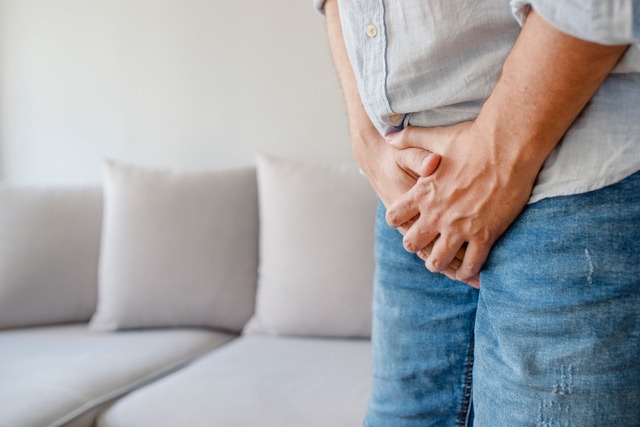Overactive bladder is characterized by a lack of control over the urge to urinate. Men with an overactive bladder experience an intense, urgent need to urinate at times when the bladder isn’t actually full. They may need to urinate more frequently during the day or at night and leakages may become an issue.
This condition gets worse with age and is often associated with benign prostatic hyperplasia (BPH).


What diseases can cause symptoms of overactive bladder in men?
- Diabetes, multiple sclerosis, Parkinson's disease
- Recent pelvic surgery (eg. lower bowel surgery or intervention on the bladder or reproductive organs)
- Spinal cord injury, stroke, Alzheimer's disease
- Urinary tract infections
- A benign enlargement of the prostate
- Bladder stones
- A tumor or inflammation of the bladder.
- Chronic pelvic pain syndrome or prostatitis
- Nocturnal polyuria
What are the symptoms of overactive bladder in men?
- A frequent need to urinate (pollakiuria)
- A need to go to the bathroom regularly due to anxiety over having to urinate at inappropriate times
- Urine leakage as a result of not being able to get to the bathroom in time
What are the risk factors for an overactive bladder in men?
- Excessive consumption of caffeinated beverages
- Urinary tract infections
- Nervous system disorders
- Pelvic floor problems, such as hypertonicity
- Pelvic floor pain
How can an overactive bladder in men be prevented?
- Try to maintain good bladder control by avoiding unnecessary trips to the bathroom.
- Don’t limit how much you drink but do change your drinking habits.
- Avoid certain bladder-irritating beverages such as caffeinated drinks, soda pop and acidic fruit juices and diuretics such as alcohol.
- Avoid certain foods such as citrus fruits, spicy foods, vinegar and chocolate
- Don’t drink after dinner or at least three hours before bedtime.
- Always empty your bladder before going to bed.
- Maintain a functional pelvic floor in order to have adequate muscle support.
- Seek treatment for symptomatic benign prostatic hyperplasia.
How is an overactive bladder in men diagnosed?
If signs and symptoms of overactive bladder present themselves and become bothersome, Dr. Marois will ask the patient to undergo various tests and assessments in order to make a diagnosis.
These may include the following:
These may include the following:
- A review of the patient’s medical history and a physical exam
- A rectal exam
- A questionnaire to assess the severity of bladder and BPH disorders and their impact on the patient’s quality of life.
- A Urinalysis
- A patient journal of urination habits over several 24-hour periods
- Blood tests (such as PSA and creatinine)
- An ultrasound of the kidneys or bladder
- A post-void bladder ultrasound to determine the quantity of urine remaining in the bladder after urination
- A cystoscopy
- A urodynamic assessment
What non-medicinal methods are used to treat overactive bladder in men?
For overactive bladder treatments to be effective, they must be followed diligently. Some non-medicinal treatment options include:
- Various lifestyle changes (eg. avoiding caffeine and alcohol)
- Monitored bladder rehabilitation
- Various perineal rehabilitation exercises that decrease the urge to urinate
- Stimulation of the tibial nerve, which is situated at the ankle and plays an important role in bladder control (this technique is taught at Dr. Marois’ urology clinics)
What medical treatments are available to men with an overactive bladder?
- It should be noted that among older men with BPH, treatments targeting urination problems can actually aggravate symptoms associated with overactive bladder.
- Certain medications can be prescribed to reduce the frequency of urges and help prevent urine leakage.
- Anticholinergics are thought to work by preventing stimulation of the detrusor muscle, which causes involuntary contractions. The following anticholinergics are available in Canada: Darifenacin, Fesoterodine, Flavoxate, Oxybutynin, Solifenacin, Tolterodine, and Trospium. Most of these medications are available in tablet form and some are taken only once a day. Oxybutynin is also available in transdermal patches and gels. The most common side effects of these medications are dry mouth and constipation.
- Mirabegron is a new medication for overactive bladder that doesn’t cause constipation nor dry mouth.
What surgical procedures are offered as treatment for overactive bladder in men?
Intravesical Botox injections are proposed as a treatment when oral medications cause excessive side effects or prove to be ineffective at managing uncomfortable symptoms of overactive bladder. This is the least invasive treatment, and it rarely has side-effects.
Bladder enlargement surgery is also an option. However, this procedure is rarely performed due to a high risk for complications.
An ileal conduit surgery is yet another option, but this intervention is rarely recommended.
Bladder enlargement surgery is also an option. However, this procedure is rarely performed due to a high risk for complications.
An ileal conduit surgery is yet another option, but this intervention is rarely recommended.


